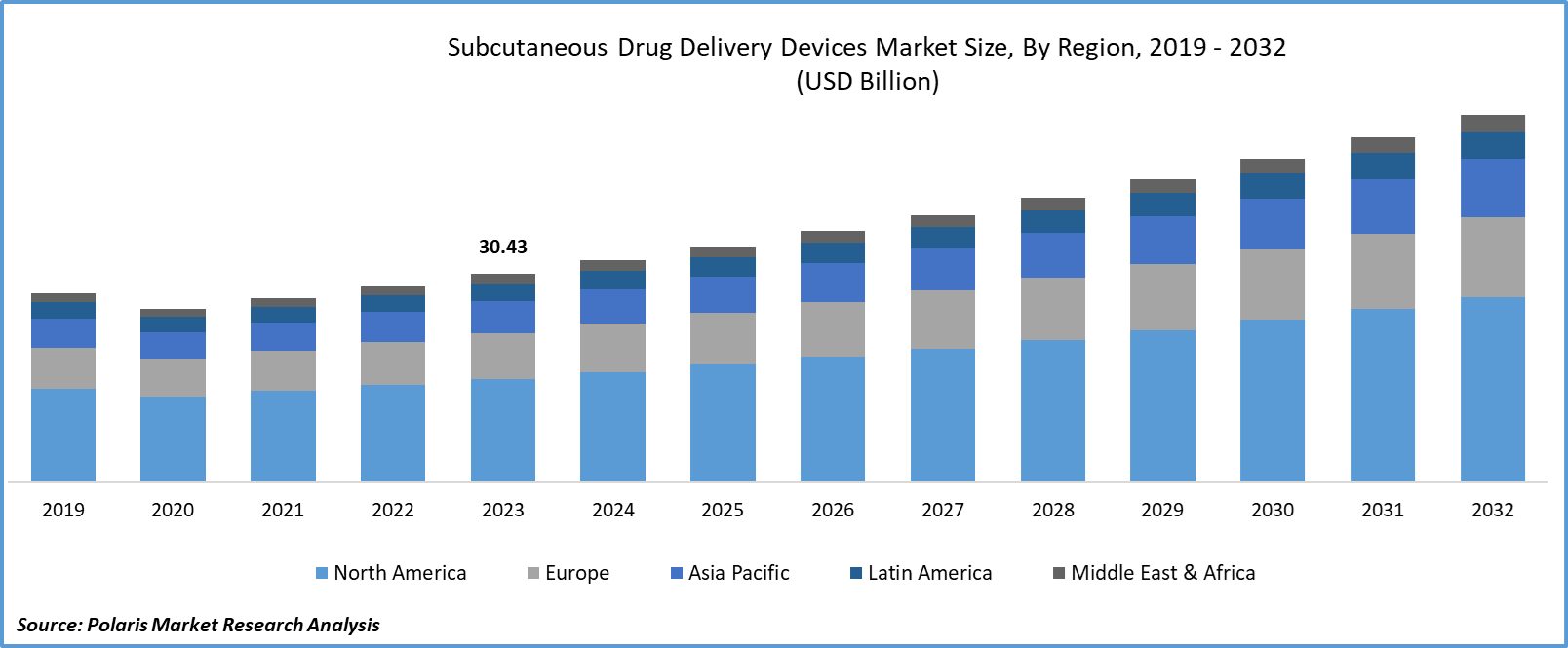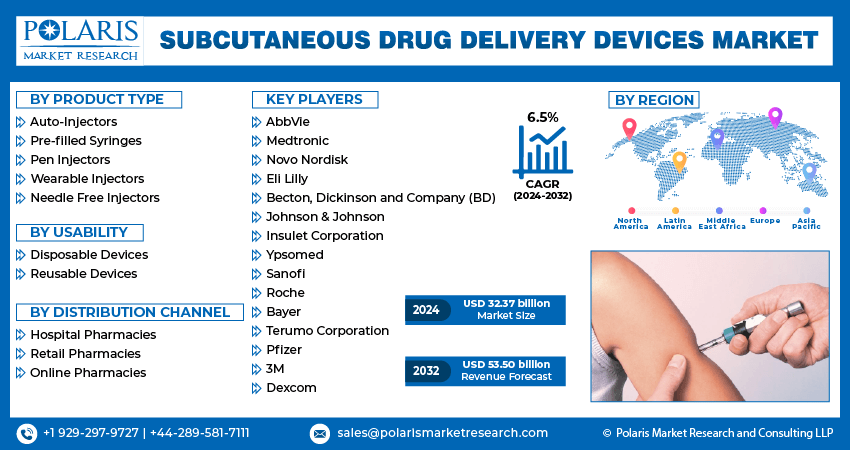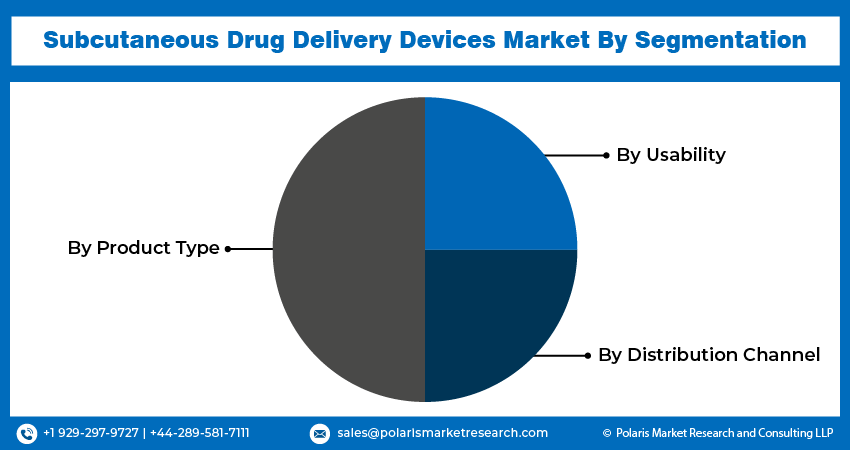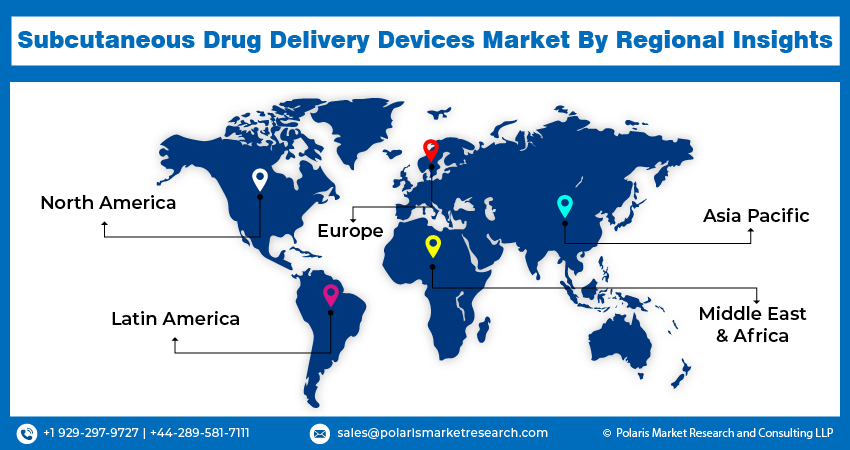
Subcutaneous Drug Delivery Devices Market Size, Share, Trends, Industry Analysis Report
: By Product Type (Auto-Injectors, Pre-Filled Syringes, Pen Injectors, Wearable Injectors, and Needle Free Injectors), By Usability, By Distribution Channel, and By Region (North America, Europe, Asia Pacific, Latin America, and Middle East & Africa) – Market Forecast, 2024–2032
- Published Date:Aug-2024
- Pages: 117
- Format: PDF
- Report ID: PM5035
- Base Year: 2023
- Historical Data: 2019-2022
Report Outlook
Global Subcutaneous Drug Delivery Devices Market Size was valued at USD 30.43 billion in 2023. The market is projected to grow from USD 32.37 billion in 2024 to USD 53.50 billion by 2032, exhibiting a CAGR of 6.5% during 2024–2032.
Subcutaneous drug delivery devices are medical tools designed to administer medication beneath the skin. They include insulin pumps and auto-injectors, offering controlled, convenient, and often pain-reduced medication delivery for chronic conditions, enhancing patient compliance and treatment efficacy. The global subcutaneous drug delivery devices market is experiencing robust growth driven by several key factors such as the increasing prevalence of chronic diseases such as diabetes and rheumatoid arthritis that require frequent medication administration. Additionally, technological advancements in device design and the development of smart devices with integrated monitoring systems are enhancing patient compliance and convenience. The trend toward personalized medicine, which necessitates precise and adjustable dosing regimens, is also contributing to the market expansion. Moreover, the growing emphasis on home healthcare and self-administration of medications fuels the adoption of subcutaneous drug delivery devices. These drivers, coupled with innovations in device technology, are expected to continue shaping the market's trajectory.

To Understand More About this Research: Request a Free Sample Report
Subcutaneous Drug Delivery Devices Market Trends
Rise of Smart Devices with Integrated Monitoring
Smart subcutaneous drug delivery devices equipped with integrated monitoring systems often feature connectivity options, such as Bluetooth or Wi-Fi, allowing real-time tracking of medication administration and patient health metrics. This integration facilitates improved patient adherence by providing automated reminders and detailed feedback on injection practices. Additionally, the collected data can be used by healthcare providers to tailor treatment plans and adjust dosages more accurately, leading to better management of chronic conditions. As technology continues to advance, the demand for these smart, connected devices is expected to grow, driving innovation and enhancing the overall patient experience. Therefore, the rise of smart devices with integrated monitoring drives the subcutaneous drug delivery devices market growth.
Growing Demand for Home Healthcare Solutions
There is a significant shift toward devices designed for self-administration with a growing emphasis on patient-centered care and the convenience of administering treatments at home. This trend is particularly prominent among patients affected by chronic conditions who require regular medication but prefer the comfort and privacy of home over frequent visits to healthcare facilities. The development of user-friendly, easy-to-operate devices that minimize discomfort and maximize safety is driving this trend. As the healthcare landscape evolves to support home-based care, the market for subcutaneous drug delivery devices tailored for at-home use is poised for substantial growth.
Advances in Personalized Medicine
Personalized medicine focuses on tailoring treatment plans to individual patient needs based on genetic, environmental, and lifestyle factors. This approach necessitates precise and flexible drug delivery methods, which has led to innovations in subcutaneous devices that allow for adjustable dosing and enhanced delivery accuracy. The ability to customize treatments improves therapeutic outcomes and reduces the risk of adverse effects. As personalized medicine becomes more prevalent, there is a growing requirement for subcutaneous drug delivery devices that can accommodate variable dosing regimens and provide optimal therapeutic benefits tailored to each patient’s unique profile.

Subcutaneous Drug Delivery Devices Market Segment Insights
Subcutaneous Drug Delivery Devices Market – Product Type Insights
In the global subcutaneous drug delivery devices market, the segmental analysis by product type reveals distinct dynamics. The auto-injectors segment dominates the market, driven by their ease of use, convenience, and the growing prevalence of chronic diseases that require frequent self-administration. Auto-injectors offer patients a user-friendly solution with pre-measured doses, reducing the complexity and discomfort associated with injections. However, the fastest-growing segment is wearable injectors, which are gaining traction due to their ability to administer continuous doses over extended periods, thereby enhancing patient compliance and comfort. Wearable injectors are particularly popular among patients needing consistent medication, such as those with diabetes or certain autoimmune conditions.
Pre-filled syringes and pen injectors hold significant market shares, offering reliable and precise drug delivery. Pre-filled syringes are valued for their convenience and minimal preparation time, while pen injectors provide a more controlled and adjustable dosing experience. Needle-free injectors, though currently holding a smaller in market share, are emerging as an innovative solution due to their noninvasive approach, which appeals to patients who are anxious about needles. Overall, while auto-injectors remain the market leader, the rapid growth of wearable injectors indicates a shift toward more advanced, patient-centric solutions in the subcutaneous drug delivery landscape.
Subcutaneous Drug Delivery Devices Market – Usability Insights
The global subcutaneous drug delivery devices market, by usability, is bifurcated into disposable and reusable devices. In 2023, the disposable segment held the dominant position in the market due to their convenience, ease of use, and reduced risk of infection, which appeals to patients and healthcare providers. These devices are designed for single-use, minimizing the need for maintenance and ensuring a sterile application with each administration.
The reusable devices segment is experiencing the highest growth, driven by rising technological advancements in the devices and the increasing focus on sustainability. Reusable devices offer long-term cost benefits and are increasingly preferred for chronic conditions requiring frequent injections, as they often come with features such as adjustable dosing and smart monitoring capabilities. As environmental concerns and the demand for cost-effective solutions rise, the reusable devices segment is expanding rapidly, although disposable devices continue to lead in market share due to their widespread acceptance and established safety standards.
Subcutaneous Drug Delivery Devices Market – Distribution Channel Insights
In the global subcutaneous drug delivery devices market, distribution channels play a crucial role in shaping market dynamics. Hospital pharmacies remain the dominating segment due to their established infrastructure and high volume of chronic disease patients requiring regular medication. These pharmacies provide direct access to a wide range of subcutaneous devices and are often the primary point of care for patients with complex medical needs.
Online pharmacies are emerging as the highest growing segment, driven by the increasing trend of e-commerce and the convenience of home delivery. The growing preference for digital solutions and the ease of ordering medical supplies online are propelling this segment's rapid expansion. Retail pharmacies also hold a significant share, offering accessibility and convenience for patients who prefer purchasing their devices in person. The overall growth of the online segment indicates a shift toward digitalization and consumer preference for flexible, home-based healthcare solutions, positioning it as a key area for future market development.
Global Subcutaneous Drug Delivery Devices Market, Segmental Coverage, 2019 - 2032 (USD billion)

Source: Secondary Research, Primary Research, PMR Database, and Analyst Review
Subcutaneous Drug Delivery Devices Market – Regional Insights
By region, the study provides the market insights into North America, Europe, Asia Pacific, Latin America, and the Middle East & Africa. North America dominates the global subcutaneous drug delivery devices market, primarily due to its advanced healthcare infrastructure, high prevalence of chronic diseases, and significant investments in medical technologies. The region benefits from well-established healthcare systems, a high rate of adoption of innovative medical devices, and strong presence of leading pharmaceutical and medical device companies. Additionally, North America’s extensive healthcare reimbursement systems and focus on technological advancements contribute to its dominance. Europe also holds a substantial market share, driven by its robust healthcare infrastructure and increasing adoption of advanced drug delivery technologies, whereas Asia Pacific is experiencing rapid growth due to rising healthcare investments and expanding patient populations.
Global Subcutaneous Drug Delivery Devices Market, Regional Coverage, 2019 - 2032 (USD billion)

Source: Secondary Research, Primary Research, PMR Database, and Analyst Review
In Europe, the subcutaneous drug delivery devices market is characterized by a strong emphasis on advanced healthcare systems and regulatory frameworks. The region benefits from well-established infrastructure and a high level of healthcare access, which supports the adoption of innovative drug delivery solutions. Europe is home to several leading medical device manufacturers and benefits from a robust network of hospital and retail pharmacies. The market is driven by the increasing prevalence of chronic diseases and the growing focus on personalized medicine. Additionally, countries in the region have supportive healthcare policies and reimbursement systems that facilitate the widespread use of advanced drug delivery technologies.
The Asia Pacific subcutaneous drug delivery devices market is experiencing rapid growth due to several factors. The region is witnessing a surge in healthcare investments, expanding infrastructure, and improving access to medical care. The increasing prevalence of chronic diseases, rising disposable incomes, and growing awareness of advanced medical technologies contribute to the market growth. Additionally, the rise of home healthcare and self-administration trends drive demand for subcutaneous devices. Countries such as China and India are significant contributors to this growth, supported by their large patient populations and increasing healthcare expenditures. The dynamic and diverse healthcare landscape in Asia Pacific presents substantial opportunities for market players.
Subcutaneous Drug Delivery Devices Market – Key Market Players and Competitive Insights
AbbVie, Medtronic, Novo Nordisk, and Eli Lilly are among the key players in the global subcutaneous drug delivery devices market. Other notable players are Becton, Dickinson and Company (BD), Johnson & Johnson, Insulet Corporation, and Ypsomed. Additionally, companies such as Sanofi, Roche, Bayer, Terumo Corporation, Pfizer, and 3M are influential in this market. These companies are recognized for their advanced technology, broad product portfolios, and strong global presence.
In terms of competitive analysis, the market is highly competitive with major players focusing on innovation and technological advancements to gain a competitive edge. Companies such as Insulet Corporation and Medtronic are leading the market with their innovative insulin delivery systems and advanced wearable devices. The increasing demand for smart and connected devices is driving competition among players to develop advanced solutions with real-time monitoring and enhanced patient compliance. Additionally, collaborations, strategic partnerships, and mergers and acquisitions are common strategies employed by key players to expand their market reach and strengthen their product offerings.
Insights into the competitive landscape reveal a trend toward personalized and patient-centric solutions. Major players are investing heavily in research and development to create devices that offer greater convenience, accuracy, and integration with digital health platforms. The focus on improving patient adherence through user-friendly designs and incorporating features such as automated reminders and data tracking is becoming increasingly important. As the market evolves, companies that successfully innovate and adapt to changing healthcare needs are likely to maintain a competitive advantage and capture a larger share of the growing market.
Medtronic is a prominent player in the global subcutaneous drug delivery devices market, known for its advanced insulin delivery systems and comprehensive portfolio of medical technologies. The company's focus on innovation is evident in its development of insulin pumps and continuous glucose monitoring systems, which cater to the needs of patients affected by diabetes. The company’s robust R&D capabilities and strong global distribution network have positioned it as a leader in the market. A recent highlight is Medtronic's announcement in May 2024 about the launch of its new MiniMed 780G insulin pump system. The system features enhanced automation and improved user experience for diabetes management.
Insulet Corporation is another key player, recognized for its innovative Omnipod insulin management systems. The company's Pod-based delivery system is notable for its convenience and ease of use, catering to diabetes patients who require insulin therapy. The company’s focus on simplifying insulin delivery with a tubeless, wearable device has made significant strides in improving patient adherence and quality of life. In July 2024, Insulet Corporation announced the expansion of its Omnipod Horizon Automated Insulin Delivery System in several new markets, enhancing its global presence and accessibility to advanced diabetes management solutions.
Key Companies in Subcutaneous Drug Delivery Devices Market
- AbbVie
- Medtronic
- Novo Nordisk
- Eli Lilly
- Becton, Dickinson and Company (BD)
- Johnson & Johnson
- Insulet Corporation
- Ypsomed
- Sanofi
- Roche
- Bayer
- Terumo Corporation
- Pfizer
- 3M
- Dexcom
Subcutaneous Drug Delivery Devices Industry Developments
- In July 2024, Insulet Corporation announced the expansion of its Omnipod Horizon Automated Insulin Delivery System.
- In May 2024, Medtronic plc announced the launch of its new MiniMed 780G insulin pump system.
Subcutaneous Drug Delivery Devices Market Segmentation
Subcutaneous Drug Delivery Devices – Product Type Outlook
- Auto-Injectors
- Pre-filled Syringes
- Pen Injectors
- Wearable Injectors
- Needle Free Injectors
Subcutaneous Drug Delivery Devices – Usability Outlook
- Disposable Devices
- Reusable Devices
Subcutaneous Drug Delivery Devices – Distribution Channel Outlook
- Hospital Pharmacies
- Retail Pharmacies
- Online Pharmacies
Subcutaneous Drug Delivery Devices – Regional Outlook
- North America
- US
- Canada
- Europe
- Germany
- France
- UK
- Italy
- Spain
- Netherlands
- Russia
- Rest of Europe
- Asia-Pacific
- China
- Japan
- India
- Malaysia
- South Korea
- Indonesia
- Australia
- Vietnam
- Rest of Asia-Pacific
- Middle East & Africa
- Saudi Arabia
- UAE
- Israel
- South Africa
- Rest of Middle East & Africa
- Latin America
- Mexico
- Brazil
- Argentina
- Rest of Latin America
Subcutaneous Drug Delivery Devices Market Report Scope
|
Report Attributes |
Details |
|
Market size value in 2023 |
USD 30.43 billion |
|
Market size value in 2024 |
USD 32.37 billion |
|
Revenue forecast in 2032 |
USD 53.50 billion |
|
CAGR |
6.5% from 2024 to 2032 |
|
Base year |
2023 |
|
Historical data |
2019–2022 |
|
Forecast period |
2024–2032 |
|
Quantitative units |
Revenue in USD billion and CAGR from 2024 to 2032 |
|
Report coverage |
Revenue Forecast, Market Competitive Landscape, Growth Factors, and Trends |
|
Segments covered |
|
|
Regional scope |
|
|
Competitive landscape |
|
|
Report format |
|
|
Customization |
Report customization as per your requirements with respect to countries, region, and segmentation. |
How the report is valuable for an organization?
Workflow/Innovation Strategy: The subcutaneous drug delivery devices market has been broadly segmented on the basis of product types, usability, and distribution channel that provides a holistic view of the market.
Growth/Marketing Strategy: To capitalize on the growing global subcutaneous drug delivery devices market, companies must focus on strategic partnerships and collaborations with healthcare providers and technology firms to drive innovation and integrate advanced features into their products. Investing in research and development to enhance device functionality, such as incorporating smart technologies and improving patient comfort, will be crucial. Additionally, expanding market reach through targeted marketing campaigns and increasing awareness about the benefits of home-based healthcare solutions can attract a broader customer base. Emphasizing sustainability by developing eco-friendly, reusable devices can also appeal to environmentally conscious consumers, offering a competitive edge in a rapidly evolving market.
FAQ's
The global market size was valued at USD 30.43 billion in 2023 and is projected to grow to USD 53.50 billion by 2032.
The global market is projected to register a CAGR of 6.5% during 2023–2032.
North America accounted for the largest share of the global market in 2023.
AbbVie, Medtronic, Novo Nordisk, and Eli Lilly are among the key players in the global market.
The auto-injectors segment dominated the market in 2023.
The hospital pharmacies segment held the largest market share in 2023.
The global subcutaneous drug delivery devices market encompasses products designed for administering medication under the skin, typically through injections. These devices are used to deliver drugs for various chronic conditions, including diabetes, rheumatoid arthritis, and multiple sclerosis. The market includes a range of devices such as prefilled syringes, auto-injectors, and wearable injectors that offer patients convenience, precision, and the ability to self-administer treatments. The market is driven by factors such as the increasing prevalence of chronic diseases, rising technological advancements leading to smart and connected devices, and the growing trend toward home healthcare solutions.
A few of the key trends in the global subcutaneous drug delivery devices market are described below: Smart Devices Integration: Increasing adoption of smart, connected devices with features such as real-time tracking, automated reminders, and data sharing capabilities. Home Healthcare Expansion: Rising demand for devices designed for self-administration at home, driven by patient preference for convenience and comfort. Personalized Medicine Growth: Development of devices that support adjustable dosing and tailored treatment regimens to align with personalized medicine approaches. Technological Advancements: Ongoing innovations in device design, including improved ergonomics, enhanced safety features, and user-friendly interfaces.
A new company entering the global subcutaneous drug delivery devices market must focus on integrating cutting-edge technology to develop smart, connected devices that offer real-time monitoring and data analytics. Emphasizing user-friendly designs that enhance patient comfort and ease of use will also be crucial. Additionally, addressing the growing demand for home healthcare by creating devices that facilitate self-administration can attract a broad customer base. Investing in sustainable solutions, such as reusable devices with eco-friendly materials, can differentiate the company in a competitive landscape. Further, forming strategic partnerships with healthcare providers and technology firms can drive innovation and expand market reach.
Companies producing subcutaneous drug delivery devices and related products, firms in the medical devices industry, and other consulting firms must buy the report.
